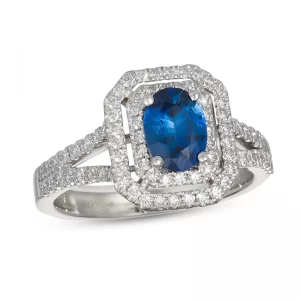So, you’ve decided that you want to buy a piece of jewelry made of white metal. There are few metals as iconic as white gold and platinum when you consider white metal as a base for your jewelry. Both have a similar aesthetic. Both are sleek and shiny. But how do you decide which white metal to pick for your piece of jewelry?
It can be tough to decide between the two, but there are a few essentials you need to consider that will help make the decision easier. Both metals have their own unique qualities that make them a popular choice for engagement rings, wedding bands, and other pieces of jewelry. Lets try a quick check – one of the two rings below is in platinum vs the other is in white gold – can you tell which is which?
If you guessed the blue ring being in platinum and the red being white gold – that was a great guess! Let’s take a closer look at white gold and platinum to help you decide which white metal is the best fit for your needs.
Which is more expensive: white gold or platinum?
The price difference between white gold and platinum can be significant. Platinum is denser and heavier than white gold, so it will make your jewelry feel more substantial. It does not corrode or tarnish as easily. It is also rarer than gold. As a result, platinum is more expensive. It can even be almost twice the price of white gold.
White gold is made of mixed alloys. That’s because pure gold is too soft and malleable to be used in jewelry. White gold comes from a mix of nickel, rhodium, and even palladium. That’s how it gets its shiny hue. As a result, the price of white gold will depend on the amount of gold used to make it. But due to the different densities and amount of metal needed, white gold jewelry is generally lower in price compared to platinum jewlery.
Is platinum more durable than white gold?
Both white gold and platinum are durable for everyday wear. However, platinum is a denser metal and is more bendable. Thus, it is liable to scratching over a period of time. That said, in general It requires a similar amount maintenance and upkeep to retain its shine.
White gold is strong because it has many durable materials mixed in it. Even though white gold may require replating over time or if it becomes scratched or damaged, it is a hardy metal and can be used for daily wear.
If budget is a major factor in your decision, it is worth keeping the following in mind. Platinum is both expensive and it needs to be cleaned regularly or its shiny appearance will dull over time. White gold requires less upkeep and therefore is better suited for daily wear but you will need to replate it once every 5 to 10 years to retain its color.
What is the difference between 14-karat vs. 18-karat white gold?
Since white gold is made from different metals, the percentage of alloys used will determine the karat measurement of white gold. 24-karat white gold is not something that is available (by definition – since 24k applies to Yellow gold), it is 14-karat and 18-karat white gold that is commonly used. That’s because 24k white gold is softer although higher in price. 14k white gold is more durable than 18k white gold. Thus, people prefer to buy 14k white gold jewelry.
Ultimately, it depends on the type of jewelry you are looking to buy and you budget.
Can you tell the difference between white gold and platinum?
When it comes to white gold and platinum, there is a noticeable difference in color. Platinum has a silvery-white hue as it is a naturally white metal. White gold has a warmer, beige color due to the different metals that are used in the making of each metal, including gold, silver, nickel, palladium, and rhodium plating, which give it its shiny white hue.
You can tell the difference in color because of its higher purity. 18k white gold looks whiter and brighter than 14k white gold. But you’ll rarely see an engagement ring without rhodium plating because that’s what gives it that really beautiful shine.
If you’re trying to decide between white gold and platinum for your next piece of jewelry, it’s important to consider the pros and cons.
Is white gold good for jewelry?
White gold jewelry is a popular choice for many people. It’s more affordable than platinum, so that automatically makes white gold a budget-friendly option. It’s durable and can be worn on a regular basis without fear of it becoming damaged. Though it will require re-plating eventually, it does not require constant cleaning and maintenance to retain its shine.
Is platinum good for jewelry?
Platinum jewelry, on the other hand, is a luxurious choice. Although it will cost more, it’s perfect for jewelry that is worn on special occasions and it adds a touch of class to any outfit. It’s durable, though it might require regular upkeep to retain its shiny cool, silvery-white color. However, any complaints about maintenance will disappear the moment you set eyes on its dashing futuristic appearance.
If you have sensitive skin, should you pick white gold or platinum?
If you have a nickel allergy or sensitive skin, your choice of white metal is important. If your skin reacts adversely to nickel, then it’s always safer to go with the higher-priced but hypoallergenic platinum. That’s because white gold might contain traces of nickel in the alloy.
Not all white gold will contain nickel. Before you make your decision, it’s always a good idea to consult your jeweler to know whether your chosen piece of jewelry made from white gold contains nickel or not.
What gems look best with white metal?
The gems that go best with white gold and platinum are darker stones or those with intense colors. Why? Darker colors stand out against the lighter metal color. They contrast with white gold and platinum.
Therefore, the best gems that will match with white metal are blue sapphires, emeralds, and rubies. Vivid amethysts, garnets, and tourmalines will work too. The darker the hue and saturation of colored gemstones, the better. Diamonds will match, too, but then again, diamonds look great with any metal!
You should avoid pairing white metal with light-color gemstones such as aquamarine, opal, and light topaz. The same goes for cheap tanzanites with a pale hue. That’s because the colors will blend with the white metal, creating a washed-out effect that will make your jewelry invisible.
The final decision boils down to your requirements and needs. What are you in the mood for?
Which is better: white gold or platinum?
Both metals have their own unique set of pros and cons, which you should take into account when making your decision.
In general, platinum is a more expensive metal than white gold. So if you are looking for a less expensive option, or prefer the look and feel of white gold – then white gold may be the right choice for you.
Ultimately, when choosing between white gold and platinum, the best way to decide which metal is right for you is to see which one fits your lifestyle and budget better. If you’re looking for something that feels luxurious and substantial, then platinum may be the metal for you. However, if you’re looking for something that is more budget-friendly and still looks great, then white gold may be your best bet. At the end of the day, the final verdict is up to you.


